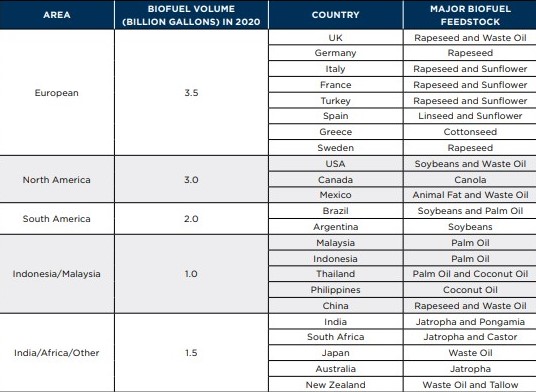ABS published the whitepaper “Biofuels as Marine Fuel” examining the potential of biofuels in shipping, giving also an overview of the various types of marine liquid biofuels that are “drop-in” fuel options for replacing conventional fuels.
As Georgios Plevrakis, ABS Director, Global Sustainability, notes in the “Biofuels as Marine Fuel”, these fuels have been identified as a highly promising carbon neutral fuels that can enter the global market relatively quickly and help approach the IMO GHG reduction targets for 2030 and beyond.
Being produced from renewable biomass, biofuels have the potential to offset the carbon emissions of a vessel due to the CO2 absorption of the feedstock, which can help counterbalance the combustion emissions. However, the total carbon reduction potential of different biofuels clearly depends on a range of factors related to their value chain

Safety of biofuels
Biofuels are biodegradable in nature, thus having an advantage in case of spills in the marine environment when compared to conventional marine fossil fuels. This is because the organic biomass composed in biofuel reacts differently in the environment than conventional petroleum marine fuel.
When biofuels come in contact with water, they quickly begin to degrade and disperse. Although considered non-toxic on land, biofuels spilled in a marine environment behave similarly to petroleum fuels until fully degrade They may still cause oil sheen and water column toxicity
In addition, specific impacts of biofuels vary by biofuel type and blend, but because of their similar properties to their petroleum counterpart, standard fuel spill recovery and clean-up practices should be followed in the case of a marine biofuel spill.
As for biofuels’ fire safety, biofuel blends and biodiesel may have very similar burning properties to their drop-in petroleum counterpart. Standard industry fire safety protocols and practices should apply when transporting, handling and burning biodiesel blends.
Neat (B100) biodiesel can be extinguished with dry chemical, foam, halon, CO2 or water spray extinguishers. Some biofuels will burn if ignited, depending on the conditions, so it is best practice to isolate manifolds and ventilation arrangements from oxidizing agents, excessive heat and ignition sources
ABS explains.
Regulatory compliance
The IMO states that in order to verify the carbon neutrality of biofuels, it is imperative to use biofuels that are sourced from sustainable feedstock and use sustainable energy sources in production. This can be achieved by following optional sustainability certification schemes, such as the International Sustainability and Carbon Certification (ISCC) scheme. However, the report highlights that current IMO mandates do not include life-cycle assessments for alternative fuels.
What is more, the European Union has prepared to transition biofuels into more applications within the transport sector by adopting the Renewable Energy Directive (EU RED). This directive is effective in the EU from June 30, 2021. According to EU RED, the contribution of advanced biofuels in transportation in the EU is targeted by member states to be at least 3.5% of total energy generated by 2030.
Most of the biofuels are expected to be used in the automotive sector, but the directive also applies to the aviation and marine transport sectors. However, the enforcement of the EU RED can differ from country to country within the European Union depending on how it becomes implemented into national legislation. Production of advanced biofuels is expected to minimize the overall direct and indirect land-use impacts from less sustainable sources of feedstock. EU countries are encouraged to limit the source of biomass from cereal, starch-rich crops, sugars and oil crops to seven percent in a RED mandate known as the Food Crop Cap
says ABS.
Continuing, biofuels can have a varying range of properties depending on various feedstocks and production processes. The International Organization for Standardization (ISO) has implemented ISO 8217, Petroleum Products – Fuels (class F) – Specifications of marine fuels, which details the specifications for marine fuel to be used in different types and sizes of diesel engines and boilers.
The standard covers marine fuels that are hydrocarbons derived from crude oil, oil sands and shale, along with hydrocarbons derived from synthetic or renewable sources and that are similar in composition to petroleum distillate fuels.
Therefore, fuels covered by this standard include distillate (identified DFA, DFZ, DFB) grades with up to seven percent FAME together with hydrotreated vegetable oil (HVO), biomass-to-liquid (BTL) and any renewable feedstock similar in composition to petroleum distillates
the whitepaper explains.
Fuel availability
Finally, one of biofuel’s main challenges is its availability to meet future potential demand. Currently, biofuel feedstock is limited because of competition with the agricultural, automotive and aviation industries and will need to be produced on an increasing scale to support uptake in the global maritime fleet.
Overall, the feedstock and fuel availability may vary depending on the location, season, regulatory and environmental conditions

However, the report adds that carbon neutral fuels such as biofuels have a great potential in helping the transition to alternative fuels.
In fact, ABS notes that biodiesels can be used in increasingly higher percentage blends to lower the emissions of marine vessels with little change to the vessel’s current operations. However, one of the current challenges of using drop-in fuels is their low availability and high cost of production.
With proper regulation at a high level, biodiesels can be a beneficial contributor to lowering GHG emissions in short sea shipping or between ports where refueling may be readily available
Now, the use of biofuels is expected to grow due to its potential similarities to marine petroleum, and ease of distribution, storage and bunkering.
































































